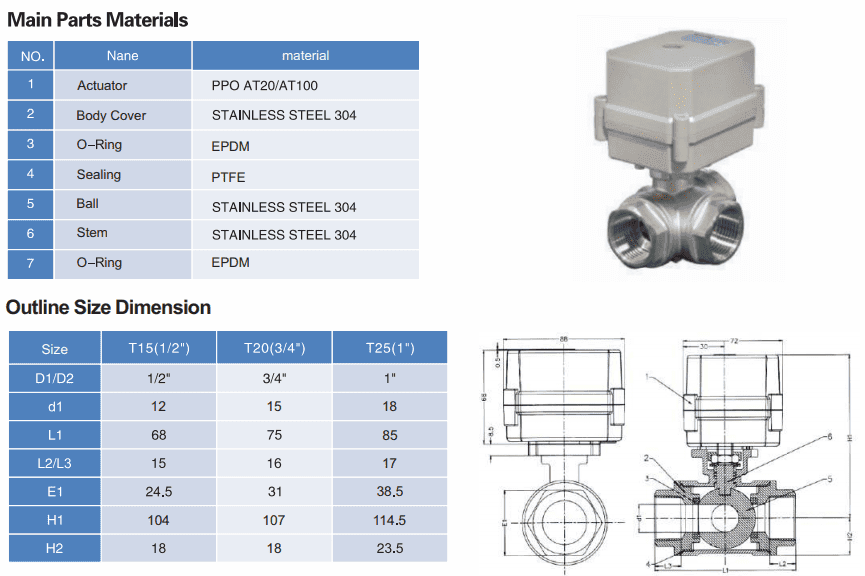COVNA Products


COVNA HK63-S-T 3 Way Stainless Steel Electric Ball Valve
The COVNA Miniature 3-Way Motorized Ball Valve is expertly engineered from brass and stainless steel and is available in a sleek gray or black finish. It accommodates operating voltages from AC110V to 230V or DC9V to 24V, with sizes ranging from 1/2" to 2". Designed for optimal performance, it delivers zero leakage and excellent sealing, and is equipped with an intuitive ON/OFF timer control. OEM branding is also available, making this versatile valve a trusted solution in applications such as air conditioning, firefighting, water treatment, pipeline purging, analytical instruments, and flue gas sampling.
- Model: HK62-S-T
- Size Range: 1/2" to 1"
- Pressure Range: 0~1.0MPa
- Material: Stainless Steel or brass
Technical Parameters of Valve Body
|
Model
|
HK63-S-T
|
Voltage
|
AC110V~230V, DC9~24V |
|
MOQ
|
1 Set
|
Working current
|
≤500mA
|
|
Open/Close time
|
≤5s |
No. of Ways
|
3 Way
|
|
Torque output
|
2.0N.M
|
End Connection
|
BSP Thread
|
|
Life time
|
70,000 times
|
Medium
|
Water, Air
|
|
Body Material
|
Brass, ss304, ss316(optional)
|
Temp. of Media
|
2°C to 90°C
|
|
Valve Ball
|
PVC, UPVC, Brass, Stainless Steel(Optional)
|
Certification
|
ISO 9001, CE, TUV, SGS
|
|
Sealing Material
|
EPDM
|
Indicator
|
Yes
|
|
Keeping Valve Open Time
|
0H:0M:OS-99H:59M:59S
|
Manual override
|
NO
|
|
Actuator material
|
Engineering Plastics
|
Ambient temperature
|
-15°C to 50°C
|
COVNA 3-WayElectric Water Ball Valve
Featuring a very low operating current, this unit can also run on battery power. It boasts an all-copper gear design that outputs highly accurate torque, making it ideally suited for multi-channel scaling systems. Serving as a diverter valve for fluid control, it finds widespread use in HVAC, solar equipment, water filters, and more. Additionally, it supports multiple control options: it can accept remote valve position signals while providing local feedback for computerized intelligence testing. Its robust sealing performance is backed by an IP67 protection rating.
The actuator on my automated valve operates, but the valve won’t turn. Why?
Most likely the valve stem or actuator coupling is broken.
Why doesn’t my valve open or close completely when the actuator operates it?
The electric actuator limit switches or the pneumatic actuator position stops are not correctly adjusted.
When I energize the solenoid on my pneumatic actuated valve, the valve won’t turn. How come?
Probably because there is no air pressure to the solenoid or dirt has jammed it. Also, debris might be trapped inside the valve. Or, the air pressure is not sufficient to operate the actuator. Remember: measure air pressure at the actuator, not at the compressor.
Can I buy an actuator from one manufacturer and mount it to a valve from another manufacturer?
Maybe. First, be sure that the actuator torque output is sufficient to turn the valve reliably. Second, you will have to fabricate a custom mounting bracket and coupling to connect the actuator to the valve.
What happens if I lose power to my electric actuator in the middle of an actuation cycle?
The valve will stop somewhere between full open and close. When power is reapplied to the original circuit, the actuator will complete the cycle.
I ordered a fail open pneumatic actuated valve by mistake. I needed a fail closed one. What can I do?
To make the change just remove the actuator from the valve and turn it, or the valve stem, 90 degrees and remount the actuator.
I’ve installed my automated valve in the line, but now I don’t know if the valve is in the open or closed position. How can I find out?
Remove the actuator from the valve and check the valve stem. Most ball valves have stem flats at right angles to the flow when the valve is in the off position. On butterfly valves check the stem flow arrow marking.
Do I have to have the solenoid valve that controls the air supply to my pneumatic actuator mounted right on the actuator?
Remove the actuator from the valve and check the valve stem. Most ball valves have stem flats at right angles to the flow when the valve is in the off position. On butterfly valves check the stem flow arrow marking.
How do I wire up my electric actuator?
Check the electric wiring schematic that came with the actuator for the correct hookup. Sometimes a copy is inside the actuator cover. If it is missing, don’t guess about the connections. Call the manufacturer for a schematic.
I’ve just installed an electric actuated valve and when I power it, it turns the valve 360 degrees and won’t shut off. What’s wrong?
The actuator is wired incorrectly (check the schematic accompanying the actuator), or the external control switch is not the correct type for the actuator.
My electric actuators cycle time is way too fast, can I slow it down?
Not unless you bought it with an optional speed control.
I just replaced a solenoid valve with an electric actuated valve and it won’t work. Why?
Actuators and solenoid valves require different types of electrical control switches. SPDT for actuators, SPST for solenoids. Check the actuator wiring schematic for the correct wiring and switch type.













